Software Alliance Connects
Two Metrology Giants
In
the latest of a series of metrology company expansions,
divestments and partnerships, Wilcox Associates Inc. and
RAM Optical Instruments Inc. have entered into an agreement
allowing RAM Optical to sell Wilcox's PC-DMIS vision metrology
software with RAM Optical's inspection products.
"PC-DMIS is the most popular coordinate measuring
machine software in the industry and the leader in CAD-based
inspection technology," says Bill Wilcox, CEO of Wilcox
Associates. "It has become the standard for CMM measurement
software in virtually all industries. This new relationship
expands PC-DMIS's reach into the optical portion of the
metrology market."
The partnership is a connector between two metrology conglomerates:
Hexagon AB, which aims to become the leader in contact metrology,
and Quality Vision International, a group of noncontact
metrology companies. Wilcox is owned by Hexagon, which is
also the parent company of Brown & Sharpe (which also
utilizes PC-DMIS) and CEJohansson. RAM
Optical (formerly CEJohansson's noncontact division) is
owned by Quality Vision International, which also owns the
noncontact metrology companies View Engineering and Optical
Gaging Products.
PC-DMIS is geometric measurement software that allows
operators to use CAD data in the measurement of manufactured
products. It works in conjunction with CMMs to allow real-time
measured data to be compared directly with the nominal CAD
data. Learn more at www.wilcox
assoc.com.
Quality Vision International acquired RAM Optical on June
3. The company provides general purpose dimensional-measurement
products. For more information, visit www.ramoptical.com.

ISO 9000 Certificate Acceptance Remains
Strong
In 1997, the International
Accreditation Forum and the International Organization for
Standardization jointly conducted a survey to determine
the acceptance of accredited certificates in international
trade. The results showed that accreditation, certification
and registration bodies, as well as businesses worldwide,
find 99.9 percent acceptance of accredited certificates.
Last year the IAF conducted a follow-up survey of three
sectors: accreditation bodies, accredited certification/registration
bodies and businesses with accredited certificates. The
findings suggest the rate of nonacceptance is still small,
less than 1 percent.
In all categories, a high percentage of respondents said
they'd benefit from a single mark on accredited certificates
indicating coverage by the IAF Mutual Recognition Agreement
(MLA). The benefit of joining the IAF MLA is that ISO 9000
conformity assessment certificates issued by certification/registration
bodies accredited by any one of the members of the MLA will
be recognized in the worldwide IAF program. Some results
follow:
n 949 ISO 9000 accreditations
were issued, covering 301,600 ISO 9000 certificates. Three
of the four reported nonacceptances were resolved by proof
of membership in the IAF MLA.
n One-third of the respondents
not covered by IAF MLA said their international trading
position would be improved by coverage in the MLA, and two-thirds
said it might be improved.
n Locally accredited certificates
were accepted by local governments in 84 percent of responses,
while nonlocally accredited MLA members were accepted only
58 percent of the time.
n 157,639 ISO 9000 certificates
were issued by the 124 respondents in this category. Of
16 nonacceptance cases, 15 were accepted after proof of
MLA coverage.
n 36 percent of the respondents
not covered by IAF MLA said their international trading
position would be improved by coverage in the MLA, and 22
percent said it might be improved.
n The 2,604 respondents in
this category reported 58 cases of nonacceptance during
the past year. Sixty-one percent said MLA coverage would
have resolved the problem, and 27 percent said it might
have resolved the problem.
n MLA coverage of accredited
certificates is preferred by 58 percent of respondents,
with another 36 percent uncertain. Eight percent said identification
of MLA coverage wouldn't help.
For a complete analysis of the survey results, e-mail
secretary@accreditationforum.com.
ISO Considers Corporate Social Responsibility
Standards
The International Organization
for Standardization Committee for Consumer Policy (ISO/COPOLCO)
is recommending the establishment of a multistakeholder
strategic advisory group to explore whether ISO should develop
corporate social responsibility standards.
The Corporate Social Responsibility Newswire defines CSR
as the integration of business operations and values whereby
the interests of all stakeholders, including customers,
employees, investors and the environment, are reflected
in the organization's policies and actions.
According to a report summary on the desirability and
feasibility of CSR standards, surveys suggest that consumers
expect firms to meet high health and safety, worker, human
rights, consumer protection, and environmental standards
regardless of where their operations are located. Furthermore,
the report states that investors and shareholders are increasingly
asking their suppliers to show that they have CSR programs
in place.
The recommendation for an advisory group was made at the
June 10 ISO/COPOLCO workshop in Port of Spain, Trinidad.
Representatives from business, industry, consumer organizations
and standards bodies attended the workshop to explore the
feasibility and needs for ISO to develop internationally
accepted parameters in the area of social responsibility.
"It was encouraging to see the standards community
seeking to reach consensus on this improvement issue and
to look for a constructive way forward," says Caroline
Warne, chair of COPOLCO. "We've made a very good start
for finding common ground and hope we've come one step closer
to considering corporate social responsibility standards
a reality."
ISO standards would only be part of an effective response
to maintaining a high level of CSR, says Kernaghan Webb,
author of the feasibility report, suggesting that a CSR
standard should be used in combination with other legal
or regulatory tools developed by international organizations.
To track the progress of the corporate social responsibility
standard proposal, visit www.iso.org.
ISO Handbook Addresses Small and Mid-Size
Businesses
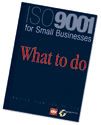 The
International Organization for Standardization has made
available a revised second edition of the ISO 9001 for Small
Businesses handbook. The publication provides advice to
small and mid-size companies on implementing ISO 9001-based
quality management systems. The
International Organization for Standardization has made
available a revised second edition of the ISO 9001 for Small
Businesses handbook. The publication provides advice to
small and mid-size companies on implementing ISO 9001-based
quality management systems.
The handbook aligns with the ISO 9001:2000 standard, which
replaced the 1994 versions of ISO 9001, 9002 and 9003. The
new standard defines the requirements for a quality management
system based on the process model and is aimed at achieving
customer satisfaction and continual performance improvement.
Written by ISO Technical Committee 176, the committee
that developed ISO 9001:2000, the handbook targets small
business operators with less time and/or resources to spend
on ISO 9001:2000 training courses. The full text of ISO
9001:2000 is included within the book. Explanations, examples
and implementation guidance is also given for each section.
Highlighted within the handbook are the eight quality
management principles on which the ISO 9001:2000 series
is based, along with tips for setting up a quality management
system with or without a consultant.
ISO 9001 for Small Businesses is available in English
for about $30 from the ISO Central Secretariat by e-mailing
sales@iso.org, or through
ISO's national member institutes, a complete list of which
can be found at www.iso.org.
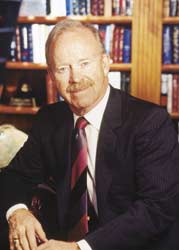 Philip
B. Crosby Medal Will Honor Distinguished Authors Philip
B. Crosby Medal Will Honor Distinguished Authors
The American Society for Quality's
board of directors has approved the Philip B. Crosby Medal
"for authoring a distinguished book contributing significantly
to the extension of the philosophy and application of the
principles, methods or techniques of quality management."
The late Crosby was a philosopher and practitioner of
quality management. A past president of ASQ, he was named
an honorary member in 2001 and was a recipient of the W.
Edwards Deming Medal. His writings focused on the concept
of zero defects as the quality performance standard, teamwork
as the principle for work, leadership as the requirement
to make progress and prevention as the means to eliminate
quality problems. His 15 books have been translated into
17 languages and have sold more than 2.5 million copies.
Recognition accorded by the medal will be a certificate
with a brief citation describing the recipient's personal
contribution and a medal with Crosby's likeness on one side,
surrounded by the words "Philip B. Crosby--Author and
Philosopher of the Global Quality Community." The reverse
side will be illustrated with an open book surrounded by
a laurel wreath. The pages of the book will read "Zero
Defects."
Eligibility criteria for the new award will be announced
this month, nominations will be accepted in November and
the presentation of the first Crosby award is scheduled
for May 2003.
Crosby's Quality College is active in teaching the fundamentals
of quality management in 20 countries around the world.
For information about Philip Crosby and Associates II Inc.,
visit www.philipcrosby.com.
To learn more about the Philip Crosby Medal, visit www.asq.org.
49 Organizations Compete for 2002 Baldrige
Award
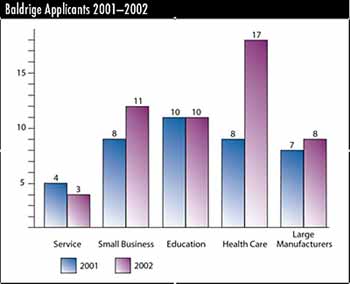 During
the next few months, examiners will evaluate 49 U.S. applicants
to determine which will receive the 2002 Malcolm Baldrige
National Quality Award. During
the next few months, examiners will evaluate 49 U.S. applicants
to determine which will receive the 2002 Malcolm Baldrige
National Quality Award.
The group includes eight large manufacturers, three service
companies, 11 small business, 10 educational organizations
and 17 health care organizations. This year marks the largest
number of health care applicants since the category was
established in 1999. Last year, applicants included eight
health care organizations, seven manufacturers, four service
companies, eight small businesses and 10 educational organizations.
As part of the Baldrige process, the applicants submitted
written answers to more than 100 questions on leadership,
strategic planning, customer and market focus, information
and analysis, human resource focus, process management,
and results. Results-oriented questions inquire about current
levels and trends in key measures and indicators.
Organizations that pass initial screening will be visited
by a team of examiners to verify information and clarify
issues and questions. Each applicant receives at least 300
hours of review and an extensive feedback report, highlighting
strengths and opportunities for improvement.
The 2001 Baldrige winners were Clarke American Checks
Inc., San Antonio (manufacturing); Pal's Sudden Service,
Kingsport, Tennessee (small business); Chugach School District,
Anchorage, Alaska (education); Pearl River School District,
Pearl River, New York (education); and the University of
Wisconsin-Stout, Menomonie, Wisconsin (education). There
were no winners in the health care or service categories.
This year's Baldrige recipients are expected to be announced
in November. For a schedule of Baldrige-related events and
for more information, visit www.quality.nist.gov.
Costly Bugs: Software Errors Add Up to
$59 Billion Annually
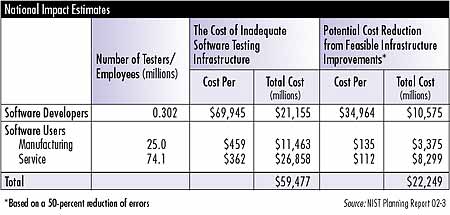 Errors
in software programs cost the U.S. economy an estimated
$59.5 billion annually, or about 0.6 percent of the gross
domestic product, according to a study commissioned by the
National Institute of Standards and Technology. At the national
level, software users shoulder more than half of the costs,
and software developers and vendors bear the remainder of
the costs. Errors
in software programs cost the U.S. economy an estimated
$59.5 billion annually, or about 0.6 percent of the gross
domestic product, according to a study commissioned by the
National Institute of Standards and Technology. At the national
level, software users shoulder more than half of the costs,
and software developers and vendors bear the remainder of
the costs.
The study also found that, although errors can't be removed
post-production, more than one-third of the costs (an estimated
$22.2 billion) can be eliminated with earlier and more effective
identification and removal of software defects. These savings
are associated with the development stage, in which most
software errors are introduced. More than half of these
errors aren't detected until later in the development process
or during post-sale software use.
In 2000, total sales of software reached approximately
$180 billion, supported by a workforce encompassing 697,000
software engineers and 585,000 computer programmers. The
study indicates that the increasing complexity of software
contributes to the high number of errors. Other factors
contributing to quality problems include marketing strategies,
limited liability by software vendors, and decreasing returns
on testing and debugging. At the core of these issues is
the difficulty of defining and measuring software quality.
The Research Triangle Institute of North Carolina conducted
the study, which was funded by NIST. It will be used as
part of a joint planning process to help identify and assess
technical needs that would improve software-testing capabilities.
The NIST Planning Report 02-3, The Economic Impacts of
Inadequate Infrastructure for Software Testing can be viewed
at www.nist.gov/director/prog-ofc/report02-3.pdf.
E-mail dherbert@nist.gov
to obtain a hard copy.
Industry
News
 Pilgrim
Software Inc. has released SmartCAPA, a completely Web-based
corrective and preventive action management solution, as
part of its SmartSolve suite of Web-based enterprise quality
management solutions built on Microsoft .NET technology. Pilgrim
Software Inc. has released SmartCAPA, a completely Web-based
corrective and preventive action management solution, as
part of its SmartSolve suite of Web-based enterprise quality
management solutions built on Microsoft .NET technology.
"Corrective actions can be initiated at the highest
levels of the company and driven down throughout the organization,"
says Chris Parsons, Pilgrim's director of marketing. "This
results in a faster time-to-compliance, improved operational
efficiency and significant reductions in risk and costs."
The solution meets the FDA 21 CFR Part 11 requirement for
electronic records and signatures. For more information,
visit www.pilgriminfo.com/qd smartcapa.htm.
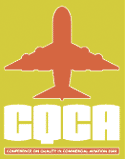 The
13th annual Conference on Quality in Commercial Aviation
is planned for Sept. 22-24 in Dallas. The theme is "Bringing
Together Operators, Maintenance Providers, Manufacturers,
Suppliers and Regulators to Assure System Safety." The
13th annual Conference on Quality in Commercial Aviation
is planned for Sept. 22-24 in Dallas. The theme is "Bringing
Together Operators, Maintenance Providers, Manufacturers,
Suppliers and Regulators to Assure System Safety."
The conference includes representatives from airlines,
aviation industry suppliers, aircraft and engine manufacturers,
the Federal Aviation Administration, and civil air authorities.
Additional information is available at www.asdnet.org/cqca.
 Applied
Statistics Inc. recently acquired the DataMyte business
of Rockwell Automation Inc. to become ASI DataMyte Inc. Applied
Statistics Inc. recently acquired the DataMyte business
of Rockwell Automation Inc. to become ASI DataMyte Inc.
DataMyte manufactures data collection devices, quality
control software, gage management software and precision
measurement solutions. Applied Statistics develops SPC software
for the manufacturing industry. Combined, the company will
support and develop both companies' products. For details,
visit www.datamyte.com.
 Hiro
Kusaka has been appointed president and CEO of Nikon Instruments
Inc. He is responsible for sales, customer service and new
product development and will head Nikon's efforts to expand
the company's presence in the digital applications business
of science and industrial markets. Hiro
Kusaka has been appointed president and CEO of Nikon Instruments
Inc. He is responsible for sales, customer service and new
product development and will head Nikon's efforts to expand
the company's presence in the digital applications business
of science and industrial markets.
Kusaka began his career with Nikon in 1974 after graduating
from Waseda University in Tokyo. Most recently, he was general
manager of the Nikon Instruments Co. in Japan. Learn more
at www.nikonusa.com.
|